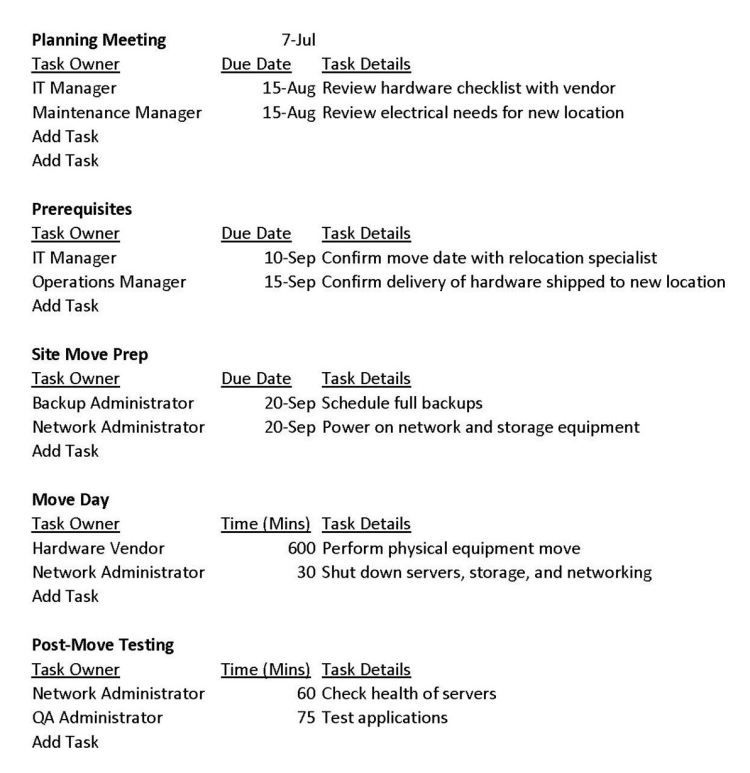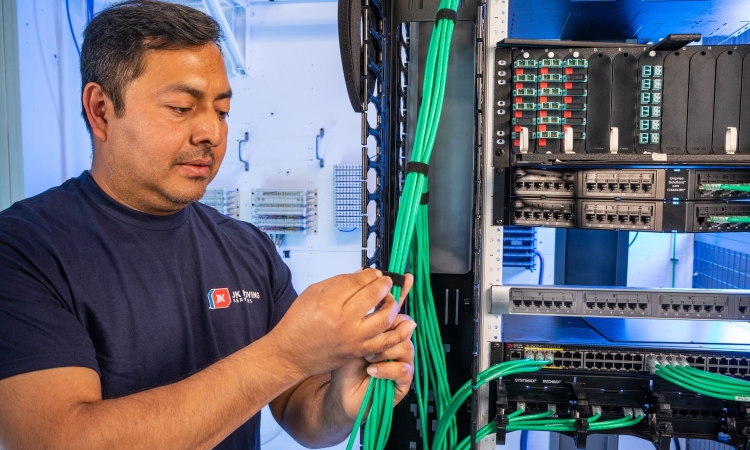When it comes to relocating a data center, the most important steps take place before a single piece of equipment is moved or byte of data transferred. The key to success is careful, thorough, and strategic planning. With a solid data center migration plan in place—one that includes detailed consideration of the physical infrastructure, IT infrastructure, budget, project management, and follow-up guidelines—the process has exponentially greater chances of flowing smoothly and avoiding costly business disruptions.
Data center relocation checklist
Data center relocations involve physically moving data center equipment to a new location. That can mean fully relocating to a new physical address or shifting areas within a building. Along with evaluating your budget and existing assets, you will need to evaluate the future location’s immediate and long-term fit for size, spacing, power load capabilities, and safety features like ventilation and temperature control. Consider this checklist of data center migration best practices to kick off your relocation process:
1. Define project goals and objectives
Establish clear goals and objectives for the data center relocation. Understand the scope of the move and set measurable targets. Learn more about our project management services to help define and achieve these goals.
2. Prioritize manageable elements
Identify and prioritize elements that offer immediate value and impact. This ensures critical components are addressed first. Check out our data center migration services for more insights on prioritizing your move.
3. Create a comprehensive project plan
Develop a detailed project plan with assigned roles, key dates, status benchmarks for each phase, and contingency plans. Our data center relocation project plan template can help you structure this plan effectively.
4. Identify prerequisites
Assess software and hardware requirements to ensure compatibility with power, temperature, and cabling at the new data center. This includes evaluating data center hardware and ensuring it meets the needs of the new environment.
5. Develop a detailed relocation checklist
Create a checklist specifically for moving hardware and equipment. This should include tasks like de-installation, packing, transportation, and re-installation.
6. Delegate relocation tasks and establish a project completion date.
Assign relocation tasks to responsible individuals or teams and set a project completion date to keep everything on track.
7. Execute and validate backups
Ensure that all critical data is backed up and validated before the move to protect against data loss and hardware failures during the relocation.
8. Coordinate shutdown, packing, and transportation
Plan and coordinate the proper shutdown of servers, equipment de-installation, packing, transportation, and re-installation at the new site.
9. Plan for post-migration and management
Develop a plan for testing and validating the new setup and establish ongoing management practices to ensure smooth operations.
Data center relocation project plan template
Once you’ve crafted your project plan and assigned key roles, it’s time to create a shared planning document to maintain visibility and accountability. Your teams may have a preferred software or shared document system in place, and anything from Excel to Google Docs can be used to craft an effective data center relocation project plan template.
This data center relocation project plan template sample demonstrates a basic outline that can be followed and tailored to your needs:
- Task Description: Clearly define each task, including hardware relocation, software setup, and testing phases.
- Task Owner: Assign responsible individuals or teams for each task.
- Time Estimates: Provide realistic timeframes for completing each task to keep the project on schedule.
- Deadlines: Set deadlines for milestones and final project completion.

Physical and strategic considerations
The physical aspect of data center migration requires special attention. It may be most cost-effective and time-saving to partner with experienced data center relocation specialists. These experts provide reliable services and ensure that your business is supported throughout the relocation process.
Additional tips
- Social Responsibility: Consider the social responsibility aspect of your move, including how the relocation impacts your employees and the environment.
- Managed Services: If your data center involves complex infrastructure, explore managed services for additional support.
- Asset Disposition: Plan for the proper disposition of outdated equipment and ensure regulatory compliance. Read about our asset management services.
- Hardware Support: Ensure that support for data center hardware is in place during and after the move to address any issues promptly.
- Console Access: Maintain console access to systems during the transition to manage and troubleshoot any issues.
Data center relocation FAQs
How do I plan a successful data center relocation?
To plan a successful data center relocation, assess your current infrastructure, define clear objectives, develop a detailed strategy, engage key stakeholders, set up a test environment, and maintain open communication throughout the process.
What are the steps for data center migration?
- Pre-migration assessment of systems
- Planning and designing the migration
- Inventory and documentation of hardware and software
- Choosing a migration method (phased, big bang, or hybrid)
- Testing systems post-migration
- Executing the migration plan
- Conducting a post-migration review to resolve any issues.
What are the requirements for a data center location?
- Strong physical security measures
- Proper environmental controls (temperature, humidity)
- Reliable and redundant power supply
- Multiple connectivity options
- Disaster recovery plans
- Compliance with relevant regulations.
How do I create a data center checklist?
- Define your objectives
- Identify key components (hardware, software, networking)
- Categorize tasks (planning, implementation, testing)
- Assign timelines for each task
- Allocate responsibilities to team members
- Regularly review and update the checklist.
By following these guidelines and utilizing a comprehensive project plan template, you can navigate your data center relocation smoothly and effectively, minimizing disruption and ensuring a successful transition to your new data center.


